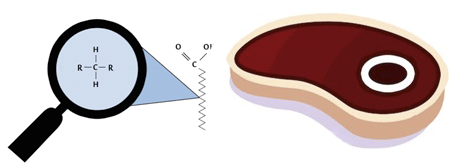At room temperature, fats with monounsaturated fatty acids are liquid and only become more solid when they get just below the freezing point of water. Foods containing monounsaturated fatty acids may help prevent diabetes and cardiovascular disease.
Polyunsaturated fatty acids
If fatty acids contain two or more double bonds, they are referred to as polyunsaturated fatty acids. An example of a polyunsaturated fatty acid is shown in Figure 5.
Cholesterol
As mentioned, the cell membrane is made up of lipids, and cholesterol is part of them.
The body itself is able to form cholesterol from fatty acids and glucose, among other things, but it is a complicated process that is not discussed here. Cholesterol also ensures that vitamin D and various hormones are formed. Cholesterol is obtained through the food you eat, but makes up only a small part. Some people have problems with their cholesterol levels and they need to think about their eating habits. As mentioned earlier, an elevated cholesterol level can cause cardiovascular diseases.
Digestion and absorption of fats
In order for the body to benefit from the fats, they must first be broken down. But the breakdown is more complicated than with the other nutrients. Fat cannot be dissolved in water, and this is a problem, as the blood’s largest component is water. The blood contains approximately 55% plasma, which is the fluid that contains water. If you have tried mixing oil and water, you will see that it cannot be done. Fat must therefore go through several processes before the blood can absorb it. Figure 6 shows the digestion of fat.
The liver produces bile, which is transported to the gallbladder. The gallbladder secretes bile acid and bile salts, which via the bile duct enter the duodenum. The bile salts emulsify the fat, that is, the fat splits into even smaller fat droplets. In the small intestine, the intestinal contents are mixed with the enzyme, lipase. The pancreas produces this enzyme that breaks down the triglycerides into glycerol and three free fatty acids.
Because glycerol and short-chain fatty acids are soluble in water, it is no problem to absorb these. However, the long-chain fatty acids need the help of bile acid. When bile acid surrounds the long-chain fatty acids, they are converted into micelles. Micelles are very small and water-soluble particles and this means that they can be transported more easily across the intestinal mucosa.
The intestinal mucosa contains intestinal cells. Inside the intestinal cells, glycerol and fatty acids are again bound together to form triglycerides. But, as mentioned, triglycerides are fat-soluble. This means that the body once again needs help in order to absorb triglycerides. The helpers are called kylomicrons. Before entering the bloodstream, they must first pass through so-called lymphatic vessels. The release of kylomicrons into the bloodstream can occur as long as 14 hours after a high-fat meal.
Unlike glucose and amino acids, triglycerides do not pass through the liver before they are released into the blood.







